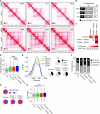STAG2 loss-of-function affects short-range genomic contacts and modulates the basal-luminal transcriptional program of bladder cancer cells
- PMID: 34648034
- PMCID: PMC8565347
- DOI: 10.1093/nar/gkab864
STAG2 loss-of-function affects short-range genomic contacts and modulates the basal-luminal transcriptional program of bladder cancer cells
Abstract
Cohesin exists in two variants containing STAG1 or STAG2. STAG2 is one of the most mutated genes in cancer and a major bladder tumor suppressor. Little is known about how its inactivation contributes to tumorigenesis. Here, we analyze the genomic distribution of STAG1 and STAG2 and perform STAG2 loss-of-function experiments using RT112 bladder cancer cells; we then analyze the genomic effects by integrating gene expression and chromatin interaction data. Functional compartmentalization exists between the cohesin complexes: cohesin-STAG2 displays a distinctive genomic distribution and mediates short and mid-ranged interactions that engage genes at higher frequency than those established by cohesin-STAG1. STAG2 knockdown results in down-regulation of the luminal urothelial signature and up-regulation of the basal transcriptional program, mirroring differences between STAG2-high and STAG2-low human bladder tumors. This is accompanied by rewiring of DNA contacts within topological domains, while compartments and domain boundaries remain refractive. Contacts lost upon depletion of STAG2 are assortative, preferentially occur within silent chromatin domains, and are associated with de-repression of lineage-specifying genes. Our findings indicate that STAG2 participates in the DNA looping that keeps the basal transcriptional program silent and thus sustains the luminal program. This mechanism may contribute to the tumor suppressor function of STAG2 in the urothelium.
© The Author(s) 2021. Published by Oxford University Press on behalf of Nucleic Acids Research.
Figures






References
-
- Romero-Pérez L., Surdez D., Brunet E., Delattre O., Grünewald T.G.P.. STAG mutations in cancer. Trends Cancer. 2019; 5:506–520. - PubMed
Publication types
MeSH terms
Substances
LinkOut - more resources
Full Text Sources
Medical
Molecular Biology Databases

